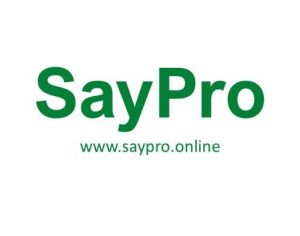SayPro Methods for Collecting Stakeholder Data
To make informed decisions in the educational system, it is crucial to gather insights from diverse stakeholders. The best methods for collecting stakeholder data include surveys, interviews, and focus groups, each with unique strengths. Below are best practices for effectively using these methods.
1.SayPro Surveys
Surveys are structured tools that collect quantitative and qualitative data from a broad audience.
Best Practices for Surveys:
✔ Define Clear Objectives – Ensure questions align with the data needed (e.g., student satisfaction, teacher needs).
✔ Use Simple & Clear Language – Avoid jargon and make questions easy to understand.
✔ Balance Open & Closed Questions – Mix multiple-choice and open-ended questions for better insights.
✔ Ensure Anonymity & Confidentiality – Increases honesty, especially for sensitive topics.
✔ Use Digital Tools – Google Forms, SurveyMonkey, or Microsoft Forms for easier distribution and analysis.
✔ Pilot Test the Survey – Test with a small group before full deployment.
Example Survey Questions:
- On a scale of 1-10, how satisfied are you with the current curriculum?
- What challenges do you face in accessing educational resources?
2.SayPro Interviews
Interviews provide in-depth qualitative insights by allowing for open discussions.
SayPro Best Practices for Interviews:
✔ Choose the Right Participants – Interview key stakeholders such as school administrators, policymakers, or teachers.
✔ Prepare a Semi-Structured Format – Use guiding questions but allow flexibility.
✔ Create a Comfortable Environment – Build trust to encourage honest feedback.
✔ Record & Take Notes – Use audio recording (with permission) for accuracy.
✔ Analyze for Common Themes – Look for patterns in responses to identify key insights.
SayPro Example Interview Questions:
- What are the biggest challenges students face in learning?
- How can school policies better support teachers?
3.SayPro Focus Groups
Focus groups involve discussions with a small, diverse group of stakeholders to gather collective insights.
Best Practices for Focus Groups:
✔ Select a Diverse Group – Include representatives from different backgrounds (students, teachers, parents).
✔ Limit Group Size (6-10 People) – Ensures everyone can participate.
✔ Have a Skilled Moderator – Guides the discussion, prevents dominance by a few voices.
✔ Encourage Open Dialogue – Use icebreakers and structured discussion topics.
✔ Record & Transcribe Discussions – Helps in analyzing themes and insights.
Example Focus Group Topics:
- How can schools improve student engagement?
- What role should technology play in education?
SayPro Choosing the Right Method
| Method | Best For | Advantages | Challenges |
|---|---|---|---|
| Surveys | Large-scale data collection | Quick, cost-effective, anonymous responses | May lack depth |
| Interviews | In-depth insights from key stakeholders | Detailed, allows follow-ups | Time-consuming, fewer participants |
| Focus Groups | Exploring diverse perspectives in discussion | Encourages dialogue, idea-sharing | Requires skilled facilitation, potential bias |


Leave a Reply
You must be logged in to post a comment.